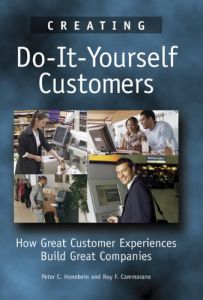Join getAbstract to access the summary!

Join getAbstract to access the summary!
Peter C. Honebein and Roy R. Cammarano
Creating Do-It-Yourself Customers
How Great Customer Experiences Build Great Companies
Thomson South-Western, 2005
What's inside?
When you make consumers do your employees' work, you save money, but then you have to train customers to do their jobs.
Recommendation
This book’s main premise may be a bit of a conceptual stretch. It notes that customers perform more services which companies formerly provided (such as booking airline reservations), and recommends that companies should encourage customers to handle even more for themselves. To accomplish this, companies should make their customers "co-producers," so every interaction becomes a "customer experience." To advance this concept, authors Peter C. Honebein and Roy F. Cammarano, both experienced business consultants, developed a model based on advising businesses to treat customers like employees, including training them to do specific tasks. For instance, companies should teach good do-it-yourself customers to move more quickly through self-service checkout lines, so the customers feel successful. The authors view even straightforward customer actions as feel-good bonding opportunities for the providing company, such as when cell phone users get to select special ring tones. While offering ample evidence of an increasing trend toward self-service, the authors combine simple examples with a perhaps overly complex model to support their premise. getAbstract.com recommends this book primarily to managers who are interested in exploring "customer experience" literature, and to companies that are deciding whether to put their customers to work.
Summary
About the Authors
Peter C. Honebein, Ph.D., has designed more than 40 products, including the system that helped map the human genome. He has experience in advertising, banking, biotech, engineering, gaming, retail and transportation, and teaches at Indiana University and the University of Nevada, Reno. He wrote Strategies for Effective Customer Education. Roy F. Cammarano has led three Inc. 500 companies and has been an executive in publishing, leisure, retail and consumer products. He wrote Entrepreneurial Transitions.
















Comment on this summary